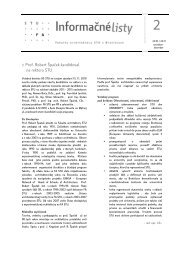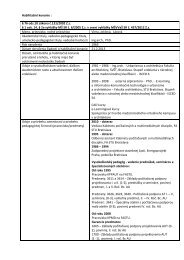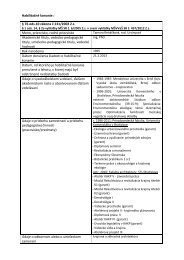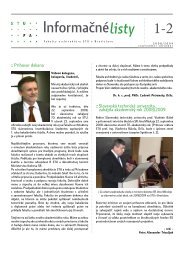ALFA 3-4/2005 - Fakulta architektúry STU
ALFA 3-4/2005 - Fakulta architektúry STU
ALFA 3-4/2005 - Fakulta architektúry STU
Create successful ePaper yourself
Turn your PDF publications into a flip-book with our unique Google optimized e-Paper software.
Ročník 9<br />
3-4 / <strong>2005</strong> ARCHITEKTONICKÉ LISTY FA <strong>STU</strong><br />
Introduction<br />
Stanislav MAJCHER<br />
HUMANIZATION OF HOSPITALS<br />
HOW CAN ARCHITECTURE MEET PSYCHOLOGICAL FACTORS IN HOSPITALS<br />
Hospitals have always been known for their cold, impersonal<br />
environments: dull colours, plain hallways, fluorescent lighting and<br />
few personal amenities. But in today’s health care market, that<br />
image is beginning to change as some health care executives<br />
realize that a relaxing, pleasant environment may play a critical<br />
role in a patient’s medical experience. A lot of studies have<br />
suggested that hospital decor and layout can help patients cope<br />
with pain, reduce the rate of hospital-acquired infection and speed<br />
healing.<br />
Almost 20 years ago an interesting study was published in<br />
“Science” magazine. In the April 1984 issue, Roger Ulrich reported<br />
that post surgical patients whose hospital rooms had an outdoor<br />
view typically recovered more quickly than those whose rooms did<br />
not. While today this may not seem shocking, the article offered<br />
some early documentation that there is a connection between<br />
healing and the environment. Something as simple as being able<br />
to look out a window and see the sky or the leaves on a tree can<br />
speed the healing process up. Why? Simply because it helps us<br />
relax.<br />
Numerous studies have told us that anxiety affects the immune<br />
system and the body’s ability to heal. As far back as 1975 we<br />
learned that when patients were prepped for heart surgery, a burst<br />
of the stress hormone cortisol (stress hormone) was released at<br />
four times the normal levels. A later study showed that patients<br />
who used guided imagery techniques to reduce anxiety before<br />
surgery required half the amount of pain medication after surgery,<br />
and their bowel function returned about a day-and-a-half earlier.<br />
Another study showed that when patients undergoing back<br />
surgery had experienced higher levels of anxiety before<br />
the surgery, they suffered more pain, tension and fatigue three<br />
months later.<br />
The study by Lawson & Phiri (2003) examines the effects of<br />
the architectural environment on the lives of patients in two<br />
hospitals, one in the general medical and the other in mental<br />
health sectors. Examining two sets of wards, one in acute general<br />
medicine and the other in mental health, the study looked at<br />
groups of patients before and after the building of new<br />
accommodation. In both cases patients were referred in similar<br />
ways and underwent similar treatment regimes often by<br />
the samestaff in both new and old wards. Findings indicated<br />
patients are sensitive to and articulate about their architectural<br />
environment. They are able to classify between poor and good<br />
environments and say clearly what they like and dislike about<br />
them. Patients appear to make significantly better progress in<br />
the new purpose-designed buildings than in their old parts. There is<br />
- 33 -<br />
considerable evidence that an overall improved atmosphere and<br />
quality of life may be one of the benefits of better places. In<br />
the mental health sector patient treatment times were reduced by<br />
14% and in the general medical sector by about 21%. Most of<br />
the architectural features apparently responsible for these benefits<br />
appear to be general place-making features rather than hospitalspecific<br />
treatment factors.<br />
Beyond the purely aesthetic issues, one very important<br />
environmental consideration is to provide the patient with as many<br />
choices as possible. This may be in the form of temperature<br />
control or lighting levels, or meal and music selections. It’s all<br />
about having options and the ability to influence or exercise<br />
control over the environment, because having options reduces<br />
stress and lessens feelings of helplessness. Another<br />
consideration is positive distractions, for example waterfalls,<br />
aquariums, fireplaces and access to gardens. In addition to<br />
the previously mentioned factors, designers nowadays are paying<br />
increased attention to the needs of the patient’s family. Therefore<br />
hospital’s layout includes a family lounge area that provides<br />
privacy for frightened, angry or overwhelmed relatives.<br />
The successful design of caring environments also concerns<br />
the needs of the health care professionals. For these<br />
professionals, the most important and fulfilling goals are to provide<br />
the best patient care as possible. When that is not achieved<br />
because of insensitive facilities, inefficient layouts or inadequate<br />
space, frustration levels run high.<br />
By improving an environment to meet the physical and emotional<br />
needs of everyone involved, it becomes a win-win situation for<br />
both the patients and staff. Good environments make us feel<br />
better, and feeling better is the key to getting better. Building<br />
design is a key issue for affecting workers, patients and<br />
productivity. The design of a building has been shown to affect<br />
the health of people who work in it. Poor design can cause “sick<br />
building syndrome” and lower productivity, and it can also affect<br />
patient’s well-being and recovery rates. There is very strong<br />
evidence that a whole range of environmental factors, including<br />
lighting, colour, aroma, views, art, modulation of space and form,<br />
manipulation of scale, proportion and rhythm, sound, texture and<br />
materials, ease and flow of movement through space, indoor and<br />
outdoor plantscape have a powerful healing and therapeutic effect<br />
on patients, which may lead to:<br />
- Faster patient recoveries<br />
- Reduced pain<br />
- Fewer cases of infection<br />
- Greater patient satisfaction

















